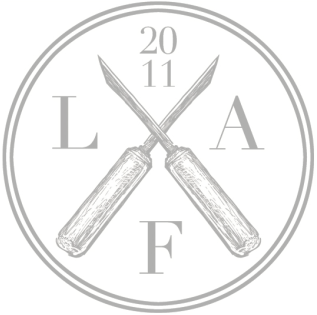I traveled to The American School of French Marquetry (ASFM) for a stage in Boulle method with Patrick Edwards and Patrice Lejeune. Boulle method refers to the process of stack cutting layers of veneer while Boulle marquetry generally refers to the brass, pewter, tortoise shell, and ebony marquetry of André Charles Boulle.
The 5 different historic marquetry types are:
1. Tarsia Certosina, cutting a cavity into a solid background and inserting a plug of veneer, bone, ivory, mother of pearl, etc. Recorded as early as 350 B.C.
2. Tarsia Geometrica, also called frisage or jeux de fond, a surface covering consisting of primarily geometric forms cut with a chisel or saw. Developed in the 14th century in Tuscany.
3. Tarsia a Toppo, developed in the 16th century. Synonymous with banding.
4. Tarsia a Incastro, developed in the 17th century. Conical cutting is a variation of this method. Also called stack cutting and Boulle method.
5. The Classic Method, also called Piece by Piece or Element par Element. Developed in 18th century France.
Pictured below is my first etude in Boulle marquetry. The chevalet holds a packet of veneers in a plane perpendicular to the saw blade, allowing the user to saw out multiple copies at once. The packet consists of a backer board, layer of grease paper, sheets of veneer, and the front board that the design is glued to. The packet is assembled with veneer tape. As elements are cut out they are organized in a tray. The parts are then assembled face down on an assembly board with hot animal protein glue. The saw kerf is filled with mastic (glue, water, sawdust), allowed to dry, sanded, and then pressed onto a substrate, adhered with hide glue. The paper is then removed from the front of the piece with cold water, a razor blade, and a scrubbing pad. The piece can then be scraped and sanded.
The assembly board is vital to French marquetry. Here is a short video of Patrick making one.
The second etude is a self portrait. It is drawn onto a piece of paper and then again with a fine tipped pen. The line is the guide for the saw blade. I can cut better than I can draw so was able to redesign a smoother picture as I went.
The third etude was similar to the first but more complex. Six sheets of veneer and more pieces to keep track of. Patrice gave me a lot of good advice. Once I understood it I could cut well. I was holding the packet in the wrong spot (too far from the blade). Patrice showed me how to hold it, how to keep the correct pressure feeding the packet into the blade, and how to turn smoothly. Notice that the blade has followed the line on the second photo in.
A few extra photos. In the first I'm cutting on the chevalet. The bottom row is Patrice with their second series of treasure boxes.
I learned so much and I recommend ASFM to anyone. It was very difficult to walk down the stairs and out the door on the last day. You build up a strong camaraderie with your classmates and teachers. For woodworkers, you get to be surrounded by passionate people who understand you and are tuned into the same world you are. You work together and learn every moment all week. I was not expecting how emotional leaving the school would be. I will be back very soon.
Patrice Lejeune, myself, and Patrick Edwards.


























